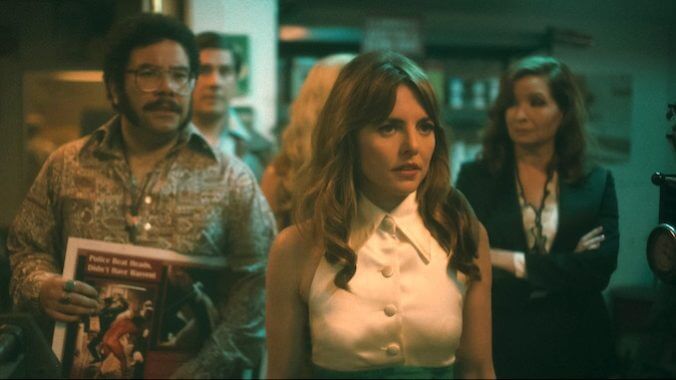Minx Fights for its Voice in a Symbolic Season 2 Finale
Photo Courtesy of Starz

When Minx first aired last March on then-HBO Max, it was a breath of fresh valley air. The comedy series by Ellen Rapoport that details the trials and tribulations of a feminist erotic magazine in the 1970s was a bright and charming addition to the streamer’s catalog. It felt like a hidden gem that would be gone too soon in the streaming era. Which is why it was so wonderful when, a few months later, the show got renewed for a second season.
But we’re in the downfall of Peak TV, so nothing gold can stay. While Warner Bros. Discovery was busy shelving completed films and deleting shows from its service, they also canceled Minx while it was at the end of filming its second season. It was a shockingly low-blow to the fledgling series that quickly scrambled to find a new home for its near-complete episodes; a home it would find in premium cable service Starz.
In Season 2, Minx got to revel in the world it established. The series went from the wastelands of Chatsworth to running a Deep Throat movie premiere, a women’s magazine conference in Las Vegas, and the quads of Vassar College. Even grander, the magazine set its sights on international dominance with a foreign expansion. Minx’s characters got to have fun with their success and the excitement popularity can bring.
All this was due to the major new addition in Minx’s second season, with Constance (Elizabeth Perkins) joining the Minx team as the new publisher of the magazine. Constance was both the mentor and villain for Season 2, wavering between an under-appreciated #Girlboss claiming her power or a corporate harbinger of death that seeks to destroy the magazine’s originality. Perkins shines as the decadent and luxurious character that is always playing more games than any other character.
Constance served as Minx’s main obstacle in its Season 2 pursuit of finding the magazine’s voice as a publication while balancing the desires of its staff and audience. Feminist Joyce (Ophelia Lovibond) always stood opposite to Doug’s (Jake Johnson) tendency to lean toward the more salacious parts of the magazine, but Season 2 pushes the characters to decide what’s really important about what Minx has to say. This meant Joyce got to go on a path of discovery, reckoning with her role as a feminist icon, a business leader, and a sister and friend. The character holds herself to such high (and often pretentious) ideals of what it means to be part of the women’s movement, but seeing her understand this not as an intellectual value but as a way of life gave Season 2 even greater depth than Minx’s flashy premise presents itself.
-

-

-

-

-

-

-

-

-

-

-

-

-

-

-

-

-

-

-

-

-

-

-

-

-

-

-

-

-

-

-

-

-

-

-

-

-

-

-

-








































